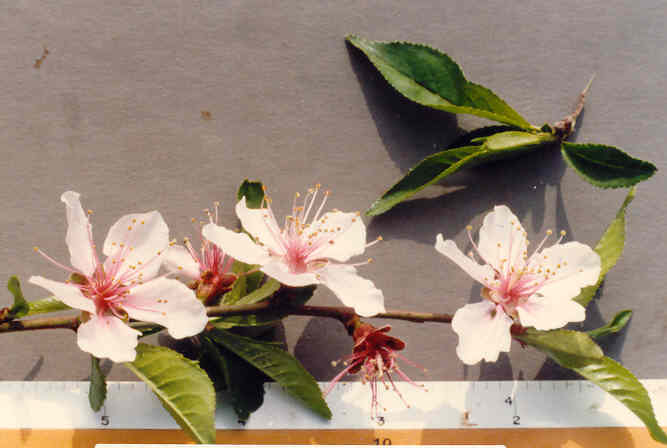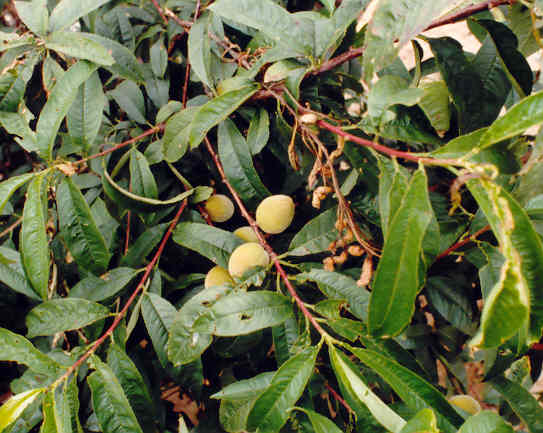
Prunus davidiana Franch.
 |
Prunus davidiana Franch.
Rosaceae (Rose Family)ChinaPeach |
March Photo
Plant Characteristics:
A very early-flowering, willow-leaved, small tree, grown for ornament
where spring frosts do not destroy the bloom or the fl.-buds are not killed by
winter, and sometimes used as a stock; branchlets glabrous: lvs. firm, 3-5 in.
long, lanceolate, tapering from near the base into very long, narrow points,
finely very sharp-serrate, glabrous, much lighter colored beneath, the slender
petiole often with undeveloped glands; fls. white, blush or light pink, 1 in. or
more across, solitary, sessile; fr. nearly globular, about 1 in. in diam., with
prominent suture, grayish or yellowish, pubescent, the flesh whitish and dry and
free from the small nearly spherical stone.
Habitat: Escape from cultivation.
Blooms in early spring.
Name:
Pru-nus: classical name of the plum.
(Bailey 537). The species name probably is in honor of a person, possibly Anstruther
Davidson, 1860-1932, California. (my comment).
General:
Rare in the study area having been found only once and this on the
Eastbluff Dr. road-bank near its intersection with Jamboree Rd.
(my comment).
Few fruits have been so loved for so long by so many as the peach.
The peach was first cultivated in China more than 4000 years ago, and
eventually spread to ancient Persia, Greece and Rome.
Through the years, this marvelous fruit has gained a place of honor in
virtually every culture. In Chinese
folklore, the fruit symbolized longevity and immortality.
The French had a singular fondness for the peach.
Peach trees lined garden paths at the palace of Versailles and the fruit
was the favorite dessert of kings from Louis XIV to Louis XVIII.
Spanish conquistadores brought the fruit to the New World-planting it in
Florida in the 16th century. American
Indians enjoyed the fruit so much they carried it as far inland as the Great
Lakes. (Harry & David Fruit
Co., Medford OR, brochure with Fruit-of-the-Month selection; in this case the
Oregold peach).
The bark of Prunus padus has been used as a diaphoretic,
expectorant and pectoral. P.
serotina, the choke cherry, has inner bark used for the stomachic action of
simple bitters and also as a cough syrup. For
the latter purpose it is an old time home remedy.
(Meyer 15,133).
The young thin bark of the cherry, Prunus virginica,
is extensively used in cough medicines as a vehicle base.
(Hutchens 63).
All parts of P. persica contain cyanide producing compounds that
are released when the peach stone kernels, the bark, and the bitter-tasting
leaves are eaten. When large
amounts of the leaves or kernels are ingested, death may result quickly.
The reaction to the poisoning is rapid, showing little outward signs and
causing death in less than an hour if a lethal amount is taken internally.
Text Ref:
Bailey 542.
Photo Ref:
Feb-Mar 88 # 24,24A; June 88 # 1A.
Identity: by R. De Ruff, confirmed by F. Roberts.
First Found: June 1985.
Computer Ref: Plant Data 356.
Plant specimen donated to UC Riverside in 2004.
Last edit 8/8/05.
 |